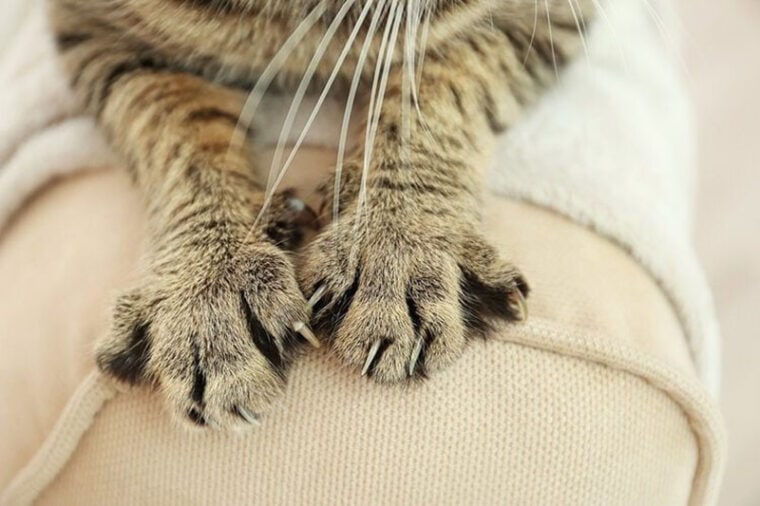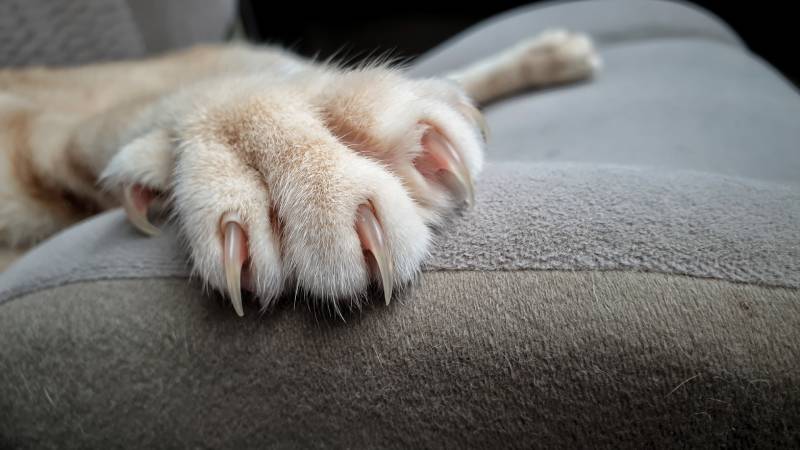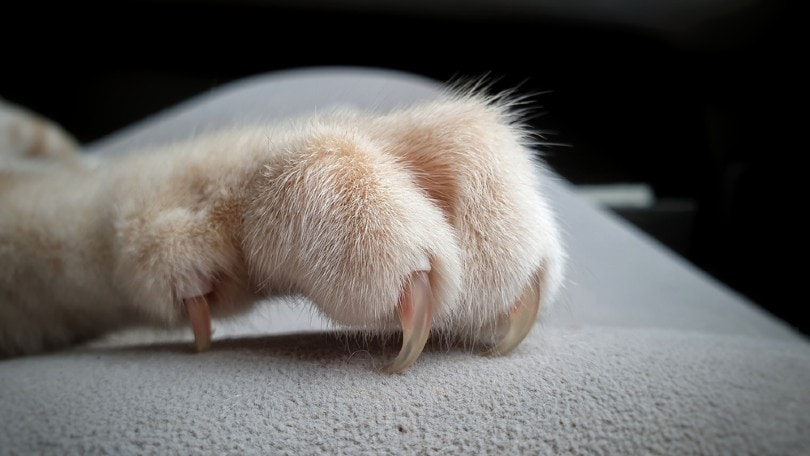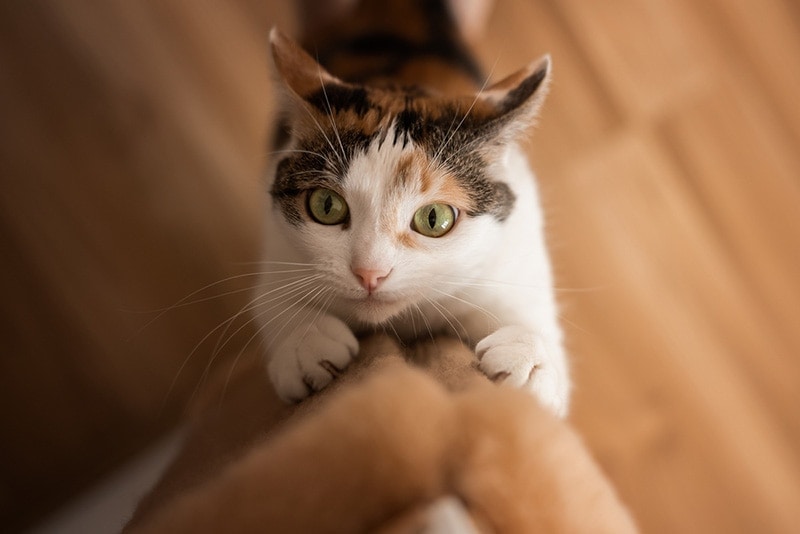
Click to Skip Ahead
Lots of owners are curious about using laser declawing methods to remove their cat’s claws. Are you one of these owners and would you like to know why it is advised against? Read on to hear the low down on laser declawing from a professional.
What Is Declawing?
Declawing (officially known as onychectomy) is a procedure where the end of the digit on a cat’s paw is removed. It can be carried out by amputation of a section of the digit, or by removing the whole of the last toe bone. Usually, the declawing methods described involve amputation of the end of the toe from the first joint after the nail bed. This is called disarticulation.
The reason behind this surgery can be for medical reasons such as the presence of chronic infection or a tumor. Shockingly, a common reason is because the owner has requested it to be done as they dislike their cat scratching things.

What Is Laser Declawing?
Laser declawing is a permanent way of removing cats’ claws and ensuring they don’t grow back. Laser declawing involves the use of a medical-grade CO2 laser to cut the digit at the first joint up from the nail bed. Alternative methods of declawing involve using a sharp scalpel blade to intersect the toe at the first joint, or bone cutters or nail trimmers to cut through the toe at the joint. With this last method, proper dislocation often does not occur, and bone fragments can be left behind which can be incredibly painful for the cat.
An alternative surgical option is an operation called a Deep Digital Flexor Tendonectomy. The tendons of the deep digital flexor are cut, and this prevents the cat from retracting its claws back into the nail sheath. Here, the cat’s nails remain intact, however, the cat is unable to scratch anything. This means that the cat’s nails will grow rapidly without any of the usual wear and tear they would experience if the cat was allowed to scratch. Therefore, the cat’s nails all need trimming regularly to prevent them from growing into the pads. This is also a controversial surgery with ethical issues.
Keeping your cat's nails trimmed can help you avoid many common paw problems. We like Hepper's Cat Nail Clipper Set because it has it all: two sizes of well-designed clippers, a nail file, and a handy carrying pouch. The clippers have built-in safety guards and locking switches, and the blades are made of sturdy, easy-to-clean stainless steel.
At Pet Keen, we've admired Hepper for many years, and decided to take a controlling ownership interest so that we could benefit from the outstanding designs of this cool cat company!
Why Do Owners Want to Declaw Their Cats?
Cats scratch with their claws and scratching is part of their normal day-to-day behavior. They scratch to defend themselves and to mark their territory. When they scratch, they deposit important chemical messengers called pheromones. Pheromones give other cats vital bits of information. Cats use pheromones as a mark of their territory to ensure they feel safe and secure.
Some cats scratch their owners or other animals and break the skin or cause considerable damage. Domesticated cats often find objects or furniture around the house to scratch as they cannot do what they would usually do in the outside world. Owners are often frustrated if cats start to scratch carpets or sofas and leave marks or rip them. Some owners request that the claws be removed from their cats to prevent them from scratching things in the house or themselves or other animals.
Some people argue that if cats are going to scratch humans and destroy furniture, declawing is a good idea as they believe it will reduce the number of cats that are rehomed or euthanized.
We’d like to think that the owners who seek declawing are only doing so because they do not understand the actual process, and once they learn more, they would choose alternative options. Lots of owners are unaware of what is involved in declawing cats, and fail to appreciate the fact that it’s a painful and distressing experience. Therefore, it’s important that owners are fully informed to be able to make the best decisions for their cats.

Why We Advise Against Laser Declawing
Declawing, regardless of the method used, is the equivalent of cutting the tip of the finger off at the level of the first knuckle. When put like this, it is understandable that most vets think it is barbaric and a form of mutilation.
International Cat Care states that they consider “declawing to be an act of mutilation and unethical for anything other than genuine therapeutic medical reasons.” Declawing cats involves the amputation of part of their digit, it is a major operation that often causes behavioral changes, altered gait, and long-term pain. All surgical procedures come with potential risks, however, it is difficult to justify the risks if the surgery is solely for the convenience of the owner.
In many countries, declawing cats is already banned or heavily frowned upon for anything other than a medical reason decided by a vet.

Is Laser Declawing Better Than Other Declawing Methods?
Some owners think that laser declawing is a more humane way of removing the claws. They believe that there is potentially less trauma using lasers as the nerve endings get sealed off which means it is less painful and there is usually less blood loss. There are some studies stating that cats that had been declawed using the laser method experienced less pain initially (in the first 48 hours after the procedure), however, all methods of declawing were proven to be painful. Less pain in one scenario compared to another extremely painful scenario does not justify the first scenario.
These studies also stated that pain levels were the same regardless of the method of declawing used 6 days post-operation. The findings from these studies may help vets if they have a case that requires a digit amputation for a medical reason, it does not justify the declawing procedure for the owner’s convenience.
Conclusion
Laser declawing is a painful procedure that has short and long-term effects on the cat’s quality of life. If there is a medical reason for the removal of the claw, the risks of surgery vs. the benefits of the removal should be discussed with your vet. Cats suffer without their claws as they use them in many different ways in their day-to-day life.
It is very difficult to justify the removal of claws just so that it is more convenient for owners of cats, therefore we strongly advise against it.
Featured Image Credit: Africa Studio, Shutterstock








